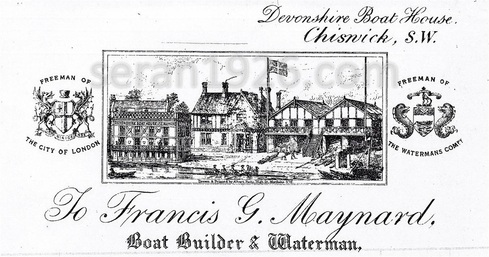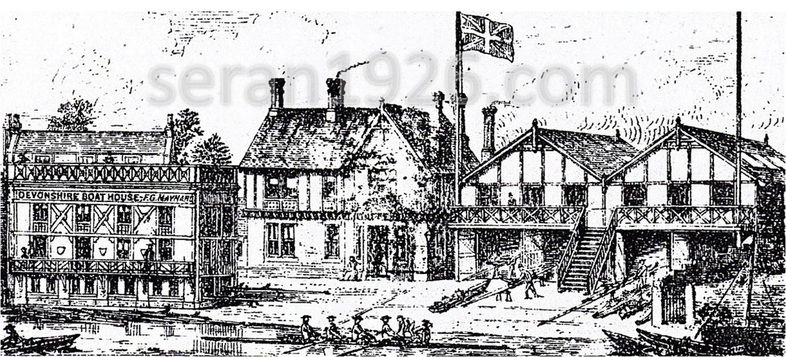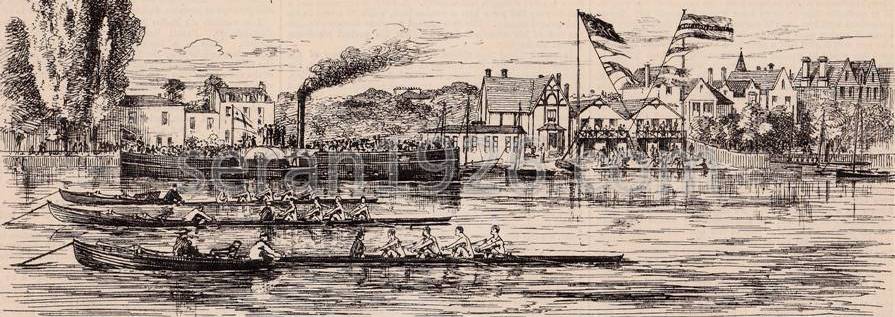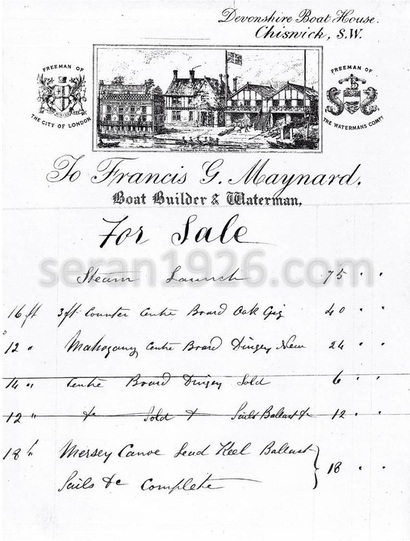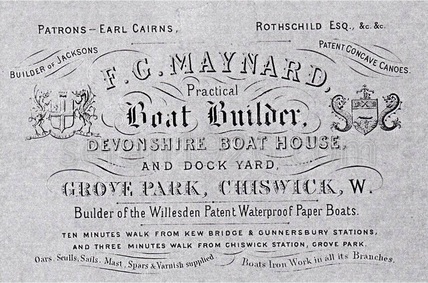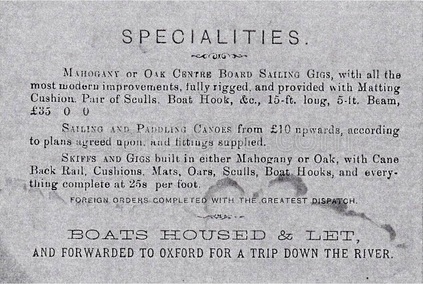Francis Goodwin Maynard
"She is a capital little sea boat, is built by Mr F. Maynard, the well-known builder at Chiswick, and is a splendid piece of workmanship".
(Manchester Courier, 22 January 1887)
(Manchester Courier, 22 January 1887)
Early career
Francis Goodwin Maynard was born in Lambeth, Surrey in 1840 the
youngest of three brothers. By 1851 the family were living in Southwark, where
his father, Henry Maynard who was a baker by trade, was running an ‘eating
house’. By the mid 1850’s Maynard was working as an apprentice boat builder
quite possibly at Henry Salter’s yard at Wandsworth and by the census of 1861
was a boarder lodging at Robert Street, Lambeth. Following an apprenticeship
lasting seven years he was admitted a Freeman of the City of London on 15
November 1861 giving him the right to carry out his craft in London's Square
Mile. He was also a Freeman of the Waterman's Company.
Maynard was certainly working closely with Henry Salter for a period in
the mid 1860’s. Salter ran an "old established" tavern and large
boat yard called the Feathers on the south bank of the Thames at Wandsworth,
with extensive boat houses and dressing rooms which were "patronised by
numerous rowing clubs... and have been the training quarters of most of our
past aquatic champions." (London Standard, 20 may 1874). On 22 September
1865, The Morning Post reported a scullers' race for £50 between two Watermen
from Putney to Mortlake. One was a waterman’s apprentice called John Caffin,
who had trained at Salter’s premises. Caffin "won with great ease",
the race being in "old-fashioned boats...Caffin's was a new one, built by
Frank Maynard, at Salter's yard." The skills and contacts gained during
this period would serve Maynard well several years later when he was to set up
his own business at Chiswick.
He married in 1862 and subsequently had four children during the 1860’s.
Henry (b. 1863), Emma (b. 1865) and Francis (b. 1867) were born in
Wandsworth, whilst the youngest, Frederick (b. 1869) was born in Barnes. All
three sons were to follow their father into the boat building
industry.
The Devonshire Boat-house
Maynard had left the employment of Henry Salter by the late
1860's and in 1869 had built a villa, boat-house and boat sheds at
the east end of Strand-on-the-Green, Chiswick, trading as "Francis G.
Maynard, Boat Builder & Waterman." He is recorded as a master
boat builder in the 1871 census, employing three men.
His yard was situated at the centre of the Chiswick boat building
industry which was already an important part of the local economy. In 1851
there were at least ten barge builders or shipwrights located
along the riverside and, from 1864, Thomas Thornycroft (1815 –
1885) and subsequently his son, John Isaac Thornycroft (1843 –
1928) built high speed launches and torpedo boats for the British and
foreign navies from their site at Church Wharf. Drawing on his past
experience at Salter's yard, Maynard was well placed to service the growing
demand for recreational river use in the mid to late
Victorian period, as portrayed in Jerome K. Jerome’s Thames classic,
“Three Men In A Boat” (1889).
“Maynard’s boat-house at the Grove Park end of Strand-on-the-Green is an excellent example of the growth of recreational boating on the Thames. Maynard built boats, hired them out, organised races and kept an eye on privately-owned craft. Some of his correspondence has survived...including notes from City businessmen instructing him as to when they wanted their boats ready; they travelled to Chiswick by rail and probably dined at the Grove Park Hotel before returning home in the evening.” Brentford and Chiswick Local History Society
The Devonshire Boat-House, named after his landlord, the Duke of
Devonshire, was well served by Kew, Gunnersbury, Chiswick and Grove Park
railway stations enabling City workers to reach his yard with relative ease. By
providing changing facilities and catering for spectators, Maynard’s yard
became a fixture of Thames rowing regatta’s. For instance, the course for the
Barnes and Mortlake amateur regatta was from Barnes bridge to his boat-house
and vice versa, according to the tide.
“As Goodwood closes the London racing season, so may Barnes be said to end the Thames rowing. Before the enterprise of May and Maynard in building their commodious boat-houses, the White Hart was the only spot where disrobing could be performed...now Maynard at Strand-on-the-Green and May at Barnes Bridge, provide for the wants of all comers and the boats can be easily brought out and sent to the post in time.” (London Standard, 5 August 1872)
By the late 1870’s Maynard was working closely with a number of local
clubs including the Gresham Rowing Club, Grove Park Rowing Club and the
Chiswick Sailing Club and from 1878 the Devonshire boat-house was the
headquarters of the Anglian Boat Club. The club used the premises as a base for
their regattas. “Everything was done by the executive for the accommodation of
the members of the press, a very large number of the friends of the club
assembling on board the steamer which accompanied the races.” (Lloyd’s Weekly
Newspaper, 12 October 1879)
Maynard was also involved in providing and preparing the boats for the
annual University Boat Race and his yard was a convenient mustering point from
where the crews could assemble and collect their boats:
“Soon after nine o’clock the Oxonians went on board Mr Louch’s steam launch, and were conveyed up river to Maynard’s boat house at the Strand-on-the-Green, just below Kew, whither their boat had been previously sent. Embarking with as little delay as possible, they paddled down on the ebb...whence they made a regular start, in view of rowing right away to Putney.” (London Daily News, 10 April 1878)
Life - and death - on the river
By 1881 Maynard employed two men and his eldest son Henry, was also a
boat builder, presumably worked at his father’s yard. In January 1885 a bizarre
tale of attempted double murder and suicide was widely reported in the press
and, in addition to providing a graphic account of events that afternoon, the
article also mentions Maynard’s employees and illustrates their experience on
the tideway.
“Last evening between 4 and 5 o’clock William Barnham and William Hudnott, employed at Maynard’s Boathouse, Strand-on-the-Green, Chiswick, were startled by cries of “Murder” and “Oh, don’t” from the Surrey shore of the River Thames, about a quarter of a mile away. Rowing in the direction of the sounds, they saw something black on the surface of the water and found it to be a woman, apparently lifeless. They at once drew her into the boat. Looking about they saw something white floating downstream, and pulling hard in that direction discovered a girl also apparently dead, about six years of age. Next at the mouth of a small creek which is spanned by an unfenced footbridge, the men found another little girl struggling in the water, and secured her also. Mr. Maynard and his two sons had by this time rowed down, and with their assistance the woman and the two girls were brought up to the boathouse. As the tide was running swiftly out and as only one man in each boat could attend to the oars this was a hard task...” (The Times, 1 January 1885)
Drowning in the Thames was not uncommon and there are numerous
instances of fatalities reported in close proximity to Maynard’s yard. For
instance in June 1872 a small pleasure boat hired from May’s boat-house was
overturned opposite Maynard’s having been caught by the wash of a passenger
steamer. Two of the three men on board were drowned. In his novel “In
Friendship’s Guise” published in 1899, William Murray Graydon describes a
similar capsizing on the tideway opposite Maynard’s boat-house:
“As he drew near Maynard’s...a churning, thumping noise, which he had disregarded before, suddenly swelled louder and warned him of possible danger. He was about off the middle of Strand-on-the-Green, and, glancing around, he saw one of the big Thames excursion steamers, laden with passengers, ploughing up-stream within fifty yards of him, but at a safe distance to the right. The same glimpse revealed a pretty picture midway between himself and the vessel – a young girl approaching in a light Canadian canoe...
The steamer glided by, and the next moment Jack was nearly opposite to the canoe. What happened then was swift and unexpected. Above the splash of the revolving paddles he heard hoarse shouts and warning cries. He saw green waves approaching, flung up in the wake of the passing vessel. As he dropped the oars and leapt anxiously to his feet, the frail canoe, unfitted to encounter such a peril, was clutched and lifted broadside by the foaming swell. Over it went instantly, and there was a flash of red and blue as the girl was flung headfirst into the river.” (“In Friendship’s Guise”, William Murray Graydon, 1899)
In August 1877, the body of Louisa Osborne was recovered. She had set
off from Maynard’s yard in what appears to have been a sailing dinghy before
being capsized and thrown into the water by a strong gust of wind. Again, in
April 1884, boys playing on the foreshore of the river near Maynard’s
boat-house found the dead body of a young man floating on the water.
Clients and craft
|
The mainstay of Maynard’s business was the building and maintenance of
traditional unpowered craft and by the 1880’s he had established an enviable
client base including Earl Cairns, the Rothschild family and Prince Giardinelli.
An advert thought to date from the 1870’s lists various vessels available for
sale through Maynard. These include a 16 ft. gig, three dinghies of between 12
ft. and 14 ft. and an 18 ft. lead keel canoe. An interesting reference to one such craft is in an account of “Canoeing on the Hardanger Fjord”:
“Now a word about my canoe. It is 14 ft. long, 30 in. beam, has well lifted bows and stern. She carries a fore-sail, main-sail, and jigger, no ballast, but I have put a loose 4 1/2” deep mahogany keel with heavy brass fittings on her, which has much improved her stability and sailing properties. She is a capital little sea boat, is built by Mr F. Maynard, the well-known builder at Chiswick, and is a splendid piece of workmanship.” (Manchester Courier, 22 January 1887) |
His yard also built numerous yachts some of which are recorded in the
Lloyd’s Registers. These were typically of between 14.6 ft. and 18 ft. L.O.A.
and 1 and 3 tons. These tended to be either cutters, such as ‘Puck’ (1882) or
luggers, such as Vixen’ (1882), ‘Imera’ (1883) ‘Ethel’ (1884) and
‘Erme’ (1884). Several were designed as well as built by Maynard.
By the early 1880’s Maynard was also experimenting with innovative
designs and materials. His business card from the 1880’s advertises his yard as
‘Builder of The Willesden Patent Waterproof Paper Boats’. These were made from
Willesden Patent Waterproof Paper which in the 1880’s was marketed as having
innumerable applications, not least in the construction of small houses and offered
a lightweight (a 16 ft. canoe weighed only 34 lbs) and inexpensive alternative
to vessels of traditional construction, winning him accolades at the Fisheries
Exhibition of 1883. He also built ‘Jackson’s Patent Concave Canoes’, which were
typically in excess of 12 ft. in length and by virtue of their hull design,
offering huge stability in the water.
A family business
Tragically,
Francis Goodwin Maynard died at the Devonshire Boat House in 1886 at the
relatively young age of forty-six. For ten years, until her death in 1896, the
business appears to have been run by his wife, Emma, and three sons. In the
1891 census Henry and Francis are recorded as boat builders and Frederick, a
sail maker. Maynard’s yard remained one of a number operating from
Strand-on-the-Green at this time including J. I. Thornycroft & Co.
Ltd., Robert Talbot & Sons, (barge builders to the Maritime Lighterage
Co.) and Messrs. Sargeant & Co. of the Strand Works, pioneers of early
electric launches.
During the
late 1880’s and 1890’s Maynard’s yard continued to build skiffs, gigs, dinghy’s
and canoes and small fishing boats but with an increased focus on yachts and
powered craft. The Lloyd’s Registers show that the number of yachts built
increased over this period and were typically of between 17 ft. and 27 ft.
L.O.A. and 1 and 3 tons and fitted with a range of rigs, principally Bermudan
but also cutters, luggers and yawls. The yard undertook builds for a
number of designers but in particular there was a close working relationship
with H. W. Ridsdale - four of his designs were built between 1897 and 1902: ‘Opal
I’ (1897), ‘Guynan’ (1900), ‘Inyanga’ (1901) and ‘My-ang-a’ (1902). Maynard’s
also continued to construct yachts to their own design during this period
including ‘Mayflower’ (1890), ‘Venture’ (1899), ‘Widgeon’ (1899) and
‘Hermes’ (1900). Although no record survives, the yard also built the hulls of
electric and steam powered launches, for instance the hull of Sargeant &
Co.’s electric launch ‘Maiden’ in 1888 and it seems likely that Maynard’s
undertook builds subcontracted from Thornycroft’s yard at Church Wharf.
Following the death of Maynard’s
widow, Emma in 1896, Frederick emigrated to America and around this time Henry
left the trade; in the 1901 census he was working as a pub landlord. The
running of the family business therefore passed to Francis Thomas Maynard in
circa 1900.
